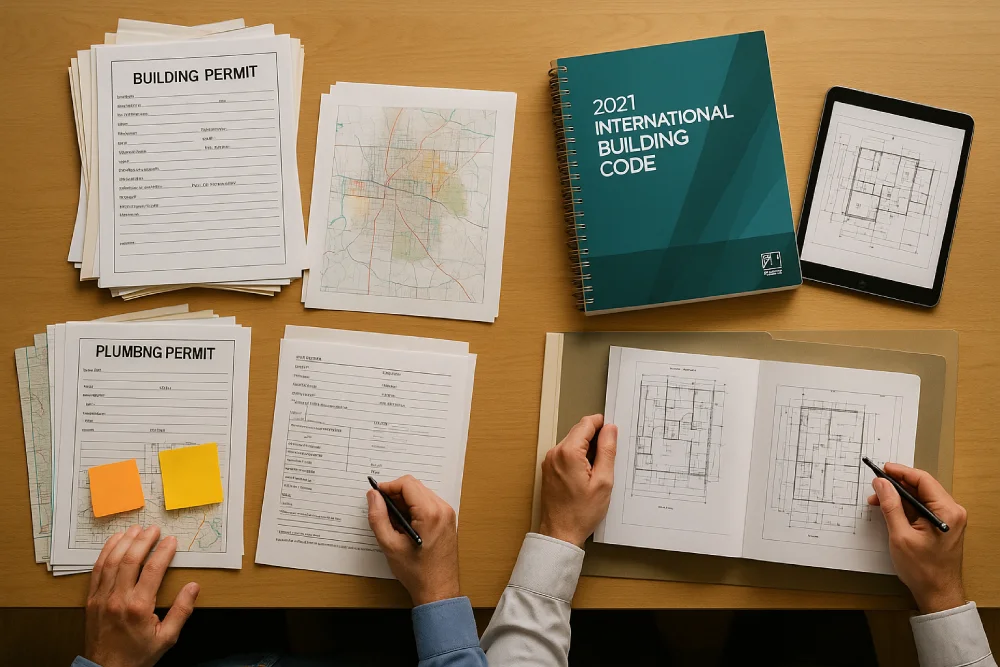
Building permit systems in the U.S. vary from statewide model‑code adoption to local home‑rule discretion, creating a mosaic of rules. Local amendments, fee structures, and documentation requirements change timelines and costs. State agencies, municipal building departments, and federal reviews can all influence approvals. Regional risks—coastal storms, heat, earthquakes—shape code priorities. Traversing permits benefits from early planning, digital platforms, and cross‑agency coordination. Continue for practical comparisons, impacts, and strategies to reduce delays and costs overall, effectively.
Although states employ a variety of authority models, the practical result is a range/gamut/array/assortment of control over building codes: at one end, ten home-rule states (e.g., Alaska, Oregon, New Jersey) allow broad local discretion to adopt or modify codes; at the other, Dillon's Rule jurisdictions restrict municipalities to powers expressly granted by state law.
The spectrum yields distinct frameworks: exclusive home-rule systems permit municipalities to select any code system and to enact amendments, producing varied local code amendment processes and illustrating the impact of home rule authority on regulatory diversity. The Department of Energy reviews model codes and issues determinations that can prompt states to review or update their codes. Conversely, states that adopt statewide codes often limit local changes to strengthening amendments or reserve codes for state projects.
Adoption follows regulatory or legislative mechanisms, with councils or agencies setting effective dates and transitions.
Where jurisdictions exercise differing degrees of code autonomy, the resulting patchwork of standards materially alters permit timelines and development costs. Regions with coastal wind loads, mountainous fire roofing rules and local amendments create processing delays and cost differentials, reducing housing supply where constraints are tighter. Notably, less than 2 percent of all new construction occurs in non-permit areas, concentrating permit-related impacts.
Inconsistent rules drive measurement and forecasting challenges, increase seasonal volatility, and cause payment errors without agreed datasets, highlighting data standardization needs and opportunities for permitting process improvements. Empirical effects include higher permit processing during peak demand, localized land-price impacts, and market volatility linked to permit fluctuations.
Clearer, harmonized code interpretation and streamlined amendment pathways can shorten approvals and moderate development costs.
Several tiers of government and specialized agencies jointly determine permit outcomes, each with distinct responsibilities and procedures. Local building departments (San Francisco, Contra Costa) manage plan reviews, inspections, services and coordinate advisory boards, shaping permit application requirements and decisions. State bodies such as California HCD set fee structures, plan documentation standards and require completed engineering packages; they use online payment systems and charge preliminary plan check fees. Federal entities (Coast Guard, DOT, DOI, DHS) review infrastructure, navigable-water and heritage impacts for larger projects. Permit approval workflow spans municipal intake, state clearance, and federal concurrence when needed; online systems (ePermits, C&S, IPIC) facilitate submissions and payments. Local building departments also ensure proposed construction meets safety requirements.
| Agency | Primary role |
| Local departments | Plan review, inspections, permits |
| State HCD | Fees, standards, documentation |
| Federal agencies | Infrastructure, navigable-water review |
Permit authorities and planners must account for regional climate, coastal, and urban realities when setting permit requirements and review standards. Regional variations—rising seas, tornado corridors, heat waves, and dense urban footprints—demand codes that prioritize building resilience and updated risk assumptions rather than historical norms.
Slow code updates and uneven local ordinances leave infrastructure exposed, increasing legal and reconstruction costs. Coastal storm surge, inland wind events, and urban heat concentration affect safety, emissions strategies, and grid interconnection needs.
Integrating disaster planning, climate projections, and coordinated zoning can reduce vulnerabilities, equitably balancing housing affordability and siting pressures. Given that buildings account for nearly 40% of U.S. carbon emissions, codes should also target energy use and materials.
Many projects reduce approval time by combining early planning with experienced expediters and consultants who translate local rules into actionable steps. Early engagement, including pre application meetings, clarifies requirements and flags conflicts before formal submission.
Professionals use phased construction and phased permitting to sequence work, enabling demolition or interior fit-outs while complex permits proceed. Digital permit platforms, templates, and automated compliance checks centralize tracking, reduce errors, and preserve data integrity.
Regular cross‑agency coordination, dedicated coordinators, and consistent meetings resolve issues and prevent silos. One‑stop permitting and consolidated hearings minimize administrative repetition. Checklists and pre‑approval pathways for repetitive models further cut review cycles.
Collectively these strategies shorten timelines, lower rejection risk, and support predictable, coordinated progress across multi‑agency projects and improve outcomes for stakeholders consistently.
In practice, adopting statewide codes simplifies baseline requirements, while local control makes room for tailored responses to climate, coastal, and urban conditions. Differences in code language and agency responsibilities affect permit timelines and costs, and can introduce administrative complexity that slows projects if not anticipated. Contractors and owners avoid many delays by engaging early, preparing clear, complete documentation, and prioritizing the regional issues that will drive reviews and inspections. Policymakers who balance consistent standards with room for local adaptation can improve predictability without undermining community resilience. Open coordination between permitting authorities, design teams, and builders, backed by transparent communication, produces the most efficient outcomes.
Local permits are issued by city or county governments and may include unique rules for climate, zoning, or environmental conditions, while national or state codes provide a uniform baseline for safety standards.
Local permits often cost more due to additional review requirements, fees, or compliance with stricter regional amendments. Costs vary widely depending on location and project scope.
Timelines can range from a few days for standard residential projects to several months for large commercial builds, especially if multiple agencies must review plans or if local amendments require extra documentation.
Regions that experience extreme weather—like coastal storms, high heat, wildfires, or earthquakes—often adapt their building codes to increase safety and resilience. These adjustments can involve stricter requirements for roof materials, structural reinforcements, or energy efficiency. While necessary for long-term protection, they also add complexity to the permit process and may extend the time needed for reviews and approvals.
Reducing delays starts with early planning. Meeting with local permitting officials before submitting your application helps clarify requirements and avoid surprises. Digital permitting systems can speed up submissions and tracking, while using professionals like permit expediters can make a big difference for complex projects. Some owners also use phased permitting to break work into smaller parts, allowing construction to begin sooner while the rest of the project is reviewed.

Whether you’re remodeling a home, expanding a business, or starting from the ground up, TriStar Built is here to guide you every step of the way. With a focus on craftsmanship, communication, and results that last, we make the construction process clear, smooth, and worth every investment.

LOCATION: 2126 James Street, Denton, TX 76205
PHONE: (940) 381-2222
© 2025 TRISTAR BUILT - ALL RIGHTS RESERVED | WEB DESIGN & SEO BY: Authority Solutions®